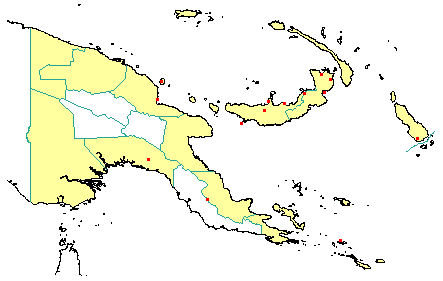
in PNGplants database
PNGTreesKey – Canarium indicum L. var. indicum |
Barry Conn (NSW) & Kipiro Damas (LAE).
Guide to trees of Papua New Guinea
Copyright held by the authors, National Herbarium of New South Wales, and Papua New Guinea National Herbarium
Amoenitates Academicae Vol. 4: 143 (1759)
Other Literature: P.W. Leenhouts, Flora Malesiana, Series 1, 266-268 (1956) Fig. 31-34.
Family: Burseraceae
Dicotyledon
Timber Group: Commercial hardwood
Field Characters: Large canopy tree (10-35 m high) or Small sub-canopy tree; Bole cylindrical or markedly fluted; straight; buttresses buttresses present; spines spines absent; aerial roots aerial roots absent; stilt roots stilt roots absent; Bark grey or brown, rough, slightly pustular or scaly or flaky, lenticels irregular; Subrhytidome (under-bark) green; less than 25 mm thick, 15.0; bark blaze consisting of one layer; strongly aromatic; pleasant; outer blaze pink or pale brown, markings absent, fibrous; inner blaze pink or pale brown, markings absent, fibrous; bark exudate (sap) absent; terminal buds not enclosed by leaves.
Indumentum: Complex hairs absent; stinging hairs absent; mature twig indumentum (hairs) present when young or soon absent, hairs dense to sparse (and then absent).
Leaves: Leaves spaced along branches, spiral (leaves occurring singly at a node and arranged spirally up the branchlet), compound (a leaf made up from two or more leaflets); petiole present, not winged, attached to base of leaf blade, rarely not swollen or swollen (often at base); leaves pinnate (unbranched with more than three leaflets); petiolule swollen (often at both tip and base); rachis present, absent, absent; leaves with a terminal leaflet (the number of leaflets odd - imparipinnate), broadest at or near middle, broadest below middle, or equally broad throughout much of length, (9.0-) 13.0-14.0 (-18.0) cm, (4.0-) 5.0-6.0 (-6.5) cm, leaflets opposite, symmetric, terminal developing leaflet buds curled back on itself; venation pinnate, secondary veins open, prominent, intramarginal veins absent; leaves lower surface green, upper surface dull dark green, indumentum (hairs) absent; absent; domatia absent; stipules present, free, laterally placed, not encircling the twig, leafy, fringed, large, persistent.
Flowers: Inflorescence terminal, flowers on a branched axis, cones absent; flowers unisexual, unisexual with male and female flowers on the same plant, stalked, flowers with many planes of symmetry, 5.0-12.0 (-15.0) mm long, diameter small (up to10 mm diam.) or diameter large (more than10 mm diam.); perianth present, with distinct sepals and petals whorls, inner perianth white or pale yellow; 3, free; stamens 6, present, joined, free of the perianth; ovary superior, carpels joined (when more than one), locules 3; styles solitary, 1.
Fruits: Infrutescence arranged on branched axis, fruit 35.0-60.0 mm long, blue or black, not spiny, non-fleshy, simple, indehiscent, drupe; seeds 1, not winged, narrow (longer than wide), seed 1-10 mm diam. (c. 10 mm diam.).
Distribution: West Sepik, East Sepik, Madang, Morobe, Western, Gulf, Northern, Milne Bay, Papuan Islands, New Britain, New Ireland, Manus & Bougainville.
 | Botanical records in PNGplants database |